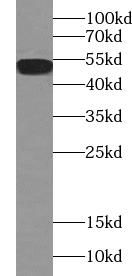Products
Acetylated tubulin (Lys40) antibody
| Size | Price |
|---|---|
| 100µg | Inquiry |
- SPECIFICATIONS
- CITATIONS
- FIGURES
- CONDITIONS
- FAQS
- Product Name
- Acetylated tubulin (Lys40) antibody
- Catalogue No.
- FNab00082
- Size
- 100μg
- Form
- liquid
- Purification
- Protein A+G purification
- Purity
- ≥95% as determined by SDS-PAGE
- Clonality
- monoclonal
- Isotype
- IgG1
- Clone ID
- 6A10
- Storage
- PBS with 0.02% sodium azide and 50% glycerol pH 7.3, -20℃ for 12 months(Avoid repeated freeze / thaw cycles.)
- Immunogen
- tubulin, alpha 1a
- Alternative Names
- Tubulin alpha-1A chain|Alpha-tubulin 3|Tubulin B-alpha-1|Tubulin alpha-3 chain|Detyrosinated tubulin alpha-1A chain|TUBA1A|TUBA3 antibody
- UniProt ID
- Q71U36
- Observed MW
- 52 kDa
- Tested Applications
- ELISA, WB, IHC, IF
- Recommended dilution
- WB: 1:500-1:5000; IF: 1:20-1:200; IHC: 1:20-1:200
 L02 cells were subjected to SDS PAGE followed by western blot with FNab00082(Acetylated tubulin(Lys40) Antibody) at dilution of 1:1000
L02 cells were subjected to SDS PAGE followed by western blot with FNab00082(Acetylated tubulin(Lys40) Antibody) at dilution of 1:1000
 Immunohistochemistry of paraffin-embedded human lung cancer tissue slide using FNab00082(Acetylated tubulin(Lys40) Antibody) at dilution of 1:50
Immunohistochemistry of paraffin-embedded human lung cancer tissue slide using FNab00082(Acetylated tubulin(Lys40) Antibody) at dilution of 1:50
- Background
- Tubulin, composed of heterodimers of alpha and beta tubulin, is the mainly component of microtubules which play important roles in cell motility, mitosis, and intracellular vesicle transport. Both alpha and beta tubulin undergo several posttranslational modifications such as polyglutamylation and acetylation/deacetylation. Tubulin acetylation occurs on lysine-40 at the N-terminal of alpha tubulin and is conserved across species. The histone deacetylase HDAC6 and SIRT2 has been identified as tubulin deacetylases. Reversible acetylation of alpha tubulin may be implicated in regulating microtubule stability, cell motility, and axon regeneration. The level of acetylated tubulin has been linked to epithelial malignancies and sensitivity to chemotherapy. In addition, acetylated tubulin has been widely used as a marker for primary cilia. This antibody is specific to the acetylated tubulin; it does not recognize non-acetylated tubulin.
- Journal:
- Aquaculture
- Author:
- Key Laboratory of Mariculture (Ocean University of China), Ministry of Education, Qingdao 266003, China
- Cited Date:
- 2024-03-15
- Product:
- Journal:
- PeerJ
- Author:
- Department of Reproductive Health and Infertility Clinic, The Affiliated Huai’an No. 1 People’s Hospital of Nanjing Medical University, Huai’an, Jiangsu, China
- Sample:
- spermatozoa
- Cited Date:
- 2024-04-19
- Product:
- Journal:
- Research Square
- Author:
- Anhui University of Traditional Chinese Medicine - East Campus: Anhui University of Chinese Medicine
- Sample:
- spermatozoa
- Cited Date:
- 2024-07-12
- Product:
How many times can antibodies be recycled?
First, usually it's not suggested to recycle antibodies. After use, buffer system of antibodies has changed. The storage condition of recycled antibodies for different customers also varies. Thus, the performance efficiency of recycled antibodies can’t be guaranteed. Besides, FineTest ever conducted the antibody recycling assay. Assay results show recycling times of different antibodies also varies. Usually, higher antibody titer allows more repeated use. Customers can determine based on experimental requirements.
Notes: After incubation, we recycle rest antibodies to centrifuge tube and store at 4℃. High titer antibodies can be stored for a minimum of one week. Reuse about three times.
What are components of FineTest antibody buffer?
Components of FineTest antibody buffer are usually PBS with proclin300 or sodium azide, BSA, 50% glycerol. Common preservative is proclin300 or sodium azide, which is widely applied in the lab and industry.
How about the storage temperature and duration of FineTest antibodies?
Most antibodies are stored at -20℃. Directly-labeled flow cytometry antibodies should be stored at 2 - 8℃. The shelf life is one year. If after sales issues for purchased antibodies appear, return or replacement is available. Usually, antibodies can be still used after the one-year warranty. We can offer technical support services.
Is dilution required for FineTest antibodies? What’s the dilute solution?
Directly-labeled flow cytometry antibodies are ready-to-use without dilution. Other antibodies are usually concentrated. Follow the dilution ratio suggested in the manual. Dilute solution for different experiments also varies. Common antibody dilution buffers are acceptable(e.g. PBST, TBST, antibody blocking buffer).
How to retrieve antibodies for immunohistochemistry?
Common retrieval buffers: Tris-EDTA Buffer(pH 9.0); Citrate Buffer(pH 6.0)
Heat induced antibody retrieval:
Method 1: Water-bath heating: Put the beaker with retrieval buffer and slide in the boiling water bath. Keep the boiling state for 15min. Naturally cool to room temperature;
Method 2: Microwave retrieval: Put the beaker with retrieval buffer and slide in the microwave oven. Heat at high power for 5min, Switch OFF for 3min, Heat at medium power for 5min. Naturally cool to room temperature.
How to choose secondary antibodies?
(1) Secondary antibodies react with primary antibodies. Thus, secondary antibodies should be against host species of primary antibodies. E.g. If the primary antibody is derived from rabbit, the relevant secondary antibody should be against rabbit. E.g. goat anti rabbit or donkey anti rabbit.
(2) Choose secondary antibody conjugates according to the experimental type, e.g. ELISA, WB, IHC etc. Common enzyme conjugated secondary antibodies are labelled by HRP, AP etc. Fluorescin or dye labelled secondary antibodies are applied in immunofluorescence and flow cytometry(e.g. FITC, Cy3).
